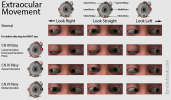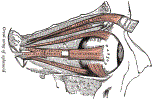Extraocular Movement, Oculomotor Nerve Structure, Conjugate Gaze, Pontine Paramedian Reticular Formation, Lateral Gaze Center, Paraabducens Nucleus, Medial Longitudinal Fasciculus, Ophthalmoplegia, Ocular Motility, Ocular Motility Disorder, Superior Rectus Muscle, Inferior Rectus Muscle, Lateral Rectus Muscle, Medial Rectus Muscle, Superior Oblique Muscle, Inferior Oblique Muscle, Orbitalis Muscle, Muller's Muscle, Levator Palpebrae Superioris Muscle, Orbicularis Oculi Muscle
- See Also
- Definitions
- Background
- Three different nerves rotate the eye's axis (line of sight)
-
Oculomotor Nerve (CN 3) innervates 3 of the 5 eye Muscles
- Allows the eye to look up, down and medially
- CN 3 Palsy results in the eye is oriented 'down and out' (functionality of the 2 remaining nerves)
-
Trochlear Nerve (CN 4) innervates the Superior Oblique Muscle
- Pulley system (trochlea) to rotate the eye downward and laterally
-
Abducens Nerve (CN 6) innervates the Lateral Rectus Muscle
- Rotates the eye laterally
- Conjugate Gaze (alignment of both eyes) is the most complex Extraocular Movement
- Requires one eye to look laterally (CN 6) while the other eye looks medially (CN 3)
- Synchrony requires coordination from several centers
- Contralateral cerebral cortex (Brodmann Areas 17,18,19 and 8)
- Lateral Gaze Center (Pontine Paramedian Reticular Formation or PPRF)
- Signals to ipsilateral CN 6
- Signals to contralateral CN 3 (via Medial Longitudinal Fasciculus)
- Anatomy
- Innervation
- Cerebral Cortex
- Voluntary Conjugate Gaze (Brodmann's Area 8)
- Involuntary Conjugate Gaze (Areas 17-19)
- Cranial Nerves
- Nucleii and Pathways
- Lateral Gaze Center (Pontine Paramedian Reticular Formation, Paraabducens Nucleus)
- Responsible for horizontal gaze and saccade eye movements
- Facilitates Conjugate Gaze by synapsing with contralateral fibers for coordinated eye movements
- Medial Longitudinal Fasciculus (MLF)
- Transmits signals between CN 3 and CN 6 to coordinate eye movements (Conjugate Gaze)
- Dysfunctional in Internuclear Ophthalmoplegia (e.g. Multiple Sclerosis, esp. if bilateral)
- Example of normal Conjugate Gaze pathway via Medial Longitudinal Fasciculus
- Cortical signal from voluntary gaze center directs left eye to look left
- Left eye CN 6 (lateral rectus) fires for the left eye to look left
- CN 6 signals Synapse with the Lateral Gaze Center
- Signals are transmitted via Medial Longitudinal Fasciculus across midline to contralateral CN 3
- Medial rectus directs the right eye to also look left (adduct to look medially)
- Lateral Gaze Center (Pontine Paramedian Reticular Formation, Paraabducens Nucleus)
- See Brainstem CVA
- Background
- Medial Range of Motion
- Medial Rectus Muscle (Cranial Nerve 3)
- Lateral Range of Motion
- Lateral Rectus Muscle (Cranial Nerve 6)
- Upward Range of Motion
- Superior Rectus Muscle (Cranial Nerve 3)
- Inferior Oblique Muscle (Cranial Nerve 3)
- Downward Range of Motion
- Inferior Rectus Muscle (Cranial Nerve 3)
- Superior Oblique Muscle (Cranial Nerve 4, Trochlear Nerve)
- Pulley system (trochlea) to rotate the eye downward and laterally
- CN 4 Paralysis results in vertical Diplopia, and Head Tilt compensating for eye rotation
- Function depends on eye position
- Eye looks down (nasal position)
- Eye rotates (temporal position)
- Eye looks down and out (neutral straight ahead position)
- Other extraocular Muscles affected Eyelid position
- Upper Eyelid Opening
- Levator Palpebrae Superioris Muscle (CN 3)
- Defect results in significant Ptosis
- Muller's Muscle or Orbitalis Muscle (cervical Sympathetic Nerves)
- Defect results in mild Ptosis
- Levator Palpebrae Superioris Muscle (CN 3)
- Upper Eyelid Closure
- Orbicularis Oculi Muscle (Cranial Nerve 7, defective in Bell's Palsy)
- Upper Eyelid Opening
- Anatomy
- Images
- See Neurologic Anatomy of the Eye
-

-
 Lewis (1918) Gray's Anatomy 20th ed (in public domain at Yahoo or BartleBy)
Lewis (1918) Gray's Anatomy 20th ed (in public domain at Yahoo or BartleBy)
-
 Lewis (1918) Gray's Anatomy 20th ed (in public domain at Yahoo or BartleBy)
Lewis (1918) Gray's Anatomy 20th ed (in public domain at Yahoo or BartleBy)
- Pathophysiology
- See Eye Deviation
- References
- Goldberg (2014) Clinical Neuroanatomy, Medmaster, p. 40-53
- Netter (1997) Atlas Human Anatomy, ICON Learning, p. 114, 126